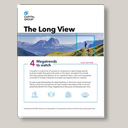Interest Rates
Technology & Innovation
Innovation isn’t just a buzzword — it’s the lifeblood of investment success. It fuels growth, drives competitiveness and shapes the future of companies. But while innovation is essential, not all emerging trends are created equal.
That’s why our portfolio managers and analysts are scouring the world for enduring trends that have the potential to transcend individual sectors and impact the broader investing landscape for years to come. Here are four megatrends our investment teams are closely watching.
1. AI revolution will reshape many industries
—Mark Casey, equity portfolio manager
Artificial intelligence has captured the imaginations of investors in tech companies, but the use of AI will likely extend well beyond generative chatbots and have lasting impacts across many industries. As interesting as I find large language models like ChatGPT, I suspect AI-powered robots could have an even bigger economic impact over the next decade — with their applications used everywhere from homes to factories to hospitals.
For example, when Amazon started working on robots to select items and put them in shipping boxes, failure rates were high and successful picks took up to two minutes each. Seven years later, the company’s new “Sparrow” robot can pick and pack two-thirds of the 100 million products in a typical Amazon warehouse, needing just seconds for each. Delivery drones and driverless taxis are more visible examples of AI-enabled robots being tested in select cities across the globe. And in health care, companies are pairing AI with robotics to improve the success of surgeries and diagnostics.
Collaborative robots are a small but rapidly growing part of industry

Source: International Federation of Robotics, World Robotics 2023. A collaborative robot is an industrial robot that can safely operate alongside humans in a shared workspace. In contrast, traditional robots are hard coded to repeatedly perform one task, work independently and remain stationary. Forecast includes both collaborative and traditional robots.
Early stock market winners in the field of AI have been concentrated in the tech industry, particularly in sub-sectors like semiconductors, cloud infrastructure and software. Companies that benefit most from advances in robotics may be spread over a broader set of industries. I want to invest in companies at the forefront of using advanced robots to improve client experiences, efficiency and profitability.
2. Health care innovation is leading to breakthroughs beyond obesity drugs
—Rich Wolf, equity portfolio manager
While obesity drugs have garnered most of the headlines, we are currently in an era of innovation across the health care landscape. Companies are actively pursuing therapies and technologies to treat — and possibly cure — major diseases and improve people’s lives.
One rapidly advancing field is cell therapy, which involves modifying cells outside the body and then infusing them into patients. This approach has gained approval for use against certain blood cancers that previously offered few treatment options. Companies are now developing cell therapies for diabetes, liver disease and heart failure.
New gene therapies are also providing opportunities for many pharma and biotech firms. Alnylam Pharmaceuticals, for example, is leading the way in gene “silencing” techniques like RNAi that can selectively suppress genes associated with certain diseases. Additionally, the progress in gene editing systems, such as CRISPR, is particularly interesting. Boston-based Vertex Pharmaceuticals achieved a significant milestone, becoming the first company to receive approval for a CRISPR-based therapy to treat sickle cell disease.
Robust pipelines could lead to new era of drug discovery

Source: Statista. As of January 2023.
Significant hurdles remain for widespread adoption of these technologies, and not all innovations will succeed. But the future of health care is exciting, and the potential for value creation over the next decade appears promising.
3. Shifting trade winds bring opportunities to new markets
—Brad Freer, equity portfolio manager
I’ll be watching and investing around shifts in global trade and supply chains in the years to come. Rising geopolitical tensions and logistical issues during the COVID pandemic forced many companies to adopt a “China Plus One” strategy, diversifying their supply chains out of China. This has resulted in emerging markets like India, Southeast Asia and Latin America benefiting from new trade partners and opportunities.
I believe this trend will continue to grow, with Mexico being a prime beneficiary of nearshoring. During my recent trip to Monterrey and Tijuana, I witnessed multinational companies like Carrier and Kia building factories to take advantage of the low-cost and efficient labor force. These multi-million-square-foot facilities with their thousands of workers reminded me of the early days of China’s manufacturing boom.
As companies diversify supply chains, new winners will emerge

Source: AmCham Shanghai 2023 China Business Report, published September 19, 2023. Based on a survey of 325 foreign companies doing business in China. Of those companies, 40% said they were redirecting investments from China to other locations, including Southeast Asia, the United States, Mexico, Europe and India, among others. Survey respondents could provide multiple responses, so total does not add up to 100%.
I’ll be looking to invest in businesses that could benefit from this change. For example, construction and materials companies will be needed to build new facilities. Real estate developers, who are getting their pick of customers in many locations, also appear attractive. And finally, nimble multinationals that embrace supply chain diversification may gain an edge over competitors not able to adapt as quickly.
4. Cultivating innovation across the agricultural landscape
—Gigi Pardasani, equity investment analyst
The world’s food system is undergoing an exciting transformation. Companies are exploring innovative solutions to revolutionize agriculture and the industries it impacts. One trend I’m following is precision agriculture — which is essentially the use of high-tech tools to grow crops more efficiently.
Farmers armed with cutting-edge technology using machine learning, geolocation and sensors are able to make smarter decisions in the field. Those who’ve already embraced precision agriculture have seen up to 30% greater productivity (compared to the prior generation of machinery) through a reduction in the number of passes on the field and improved soil. Real-time data has been a game changer, with many farmers becoming increasingly reliant on analytics and visualizations to improve their processes. Artificial intelligence could further drive improvements. While this latest technology clearly benefits agricultural machinery companies, it should also have environmental and productivity benefits for a host of other businesses.
Who’s innovating in agriculture?

Source: Capital Group. The graphic is a non-exhaustive list provided by analysts of companies working on these trends. These examples are not based on holdings or recommendations and are for illustrative purposes only.
From seed innovation to regenerative farming and even alternative proteins, the industry is evolving. The agricultural cycle can require patience, but the developments are promising. I believe these are multi-year shifts that long-term investors should have on their radar.

The Long View: Megatrends to watch webinar
CE credit available
Patience is a virtue — and a sound investment strategy
—Peter Eliot, equity portfolio manager
Most of us spend our time worrying about the short term. Our daily routines often revolve around things like planning our day, shuttling kids to and from school, completing the next work task, or tracking stock market fluctuations.
But in investing, it’s usually better to think long term. Investors often lack the patience required to capitalize on megatrends as these don’t develop in a straight line, and the market’s attention can be diverted by the latest fad. Self-driving cars, for example, once garnered the same enthusiasm that AI currently does. But the market has gone through a period of disappointment because the technology has taken awhile to develop, even as the underlying fundamentals haven’t really changed.
Reflecting on my career, I've done a lot of work analyzing the outcomes of my investment decisions. I’ve found that it really comes down to something very simple: My big mistakes were a failure of patience, and my big successes were a triumph of patience.
RNAi: ribonucleic acid interference.
CRISPR: clustered regularly interspaced short palindromic repeats.
Nearshoring: a strategy in which a company moves all or part of its production closer to the final consumer, with a goal of reducing costs and avoiding logistical setbacks.

Get The Long View: 4 megatrends to watch
Our latest insights
-
-
-
Municipal Bonds
-
Artificial Intelligence
-
Target Date
RELATED INSIGHTS
-
-
Artificial Intelligence
-
Never miss an insight
The Capital Ideas newsletter delivers weekly investment insights straight to your inbox.
On or around July 1, 2024, American Funds Distributors, Inc. will be renamed Capital Client Group, Inc.
 Mark Casey
Mark Casey
 Richmond Wolf
Richmond Wolf
 Brad Freer
Brad Freer
 Gigi Pardasani
Gigi Pardasani